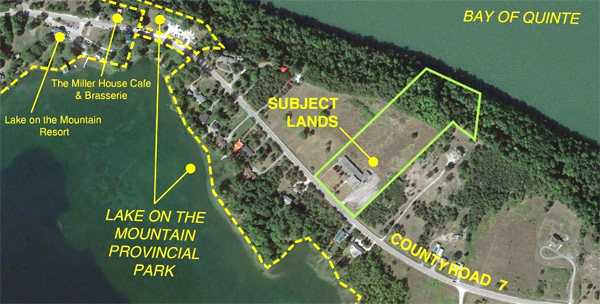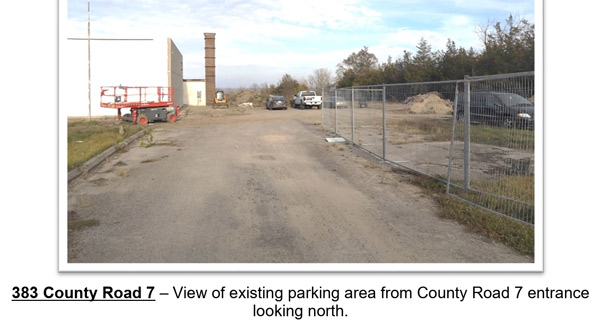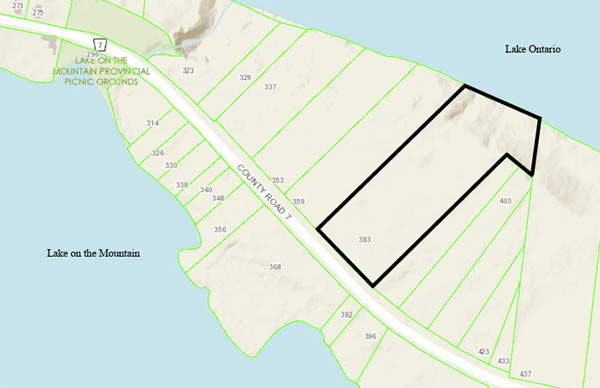Concerns over proposed culinary venue at former school
Administrator | Jul 20, 2025 | Comments 5

By Sharon Harrison
Details of how the long-derelict former North Marysburgh Centennial Central School will be transformed into a culinary school, banquet hall and 10 accommodation units, were heard at last week’s planning and development committee meeting.
The property, located at 383 County Road 7 in North Marysburgh at Lake on the Mountain, was bought some years ago by restaurateur Nick Di Donato, president of Toronto-based Liberty Entertainment Group (1234604 Ontario Inc.). Among Di Donato’s many business ventures and Toronto-based entertainment venues, Liberty Entertainment operates Toronto’s Casa Loma, as well as the recently-opened Rogers Stadium in Toronto.
Applications for a zoning bylaw amendment and site plan control have been received by the planning department to re-zone the 7.44-acre property to tourist commercial to permit an event venue and culinary school with 10 guest rooms.
Under planning’s new two-step process, no decision on this application is made by council at this first statutory overview meeting, which is intended as information-gathering only. Decision by council will happen at a future second statutory public meeting where staff will provide a report and recommendation.
 The site currently consists of a 1,281-square-metre, one-storey brick building formerly known as the North Marysburgh Centennial Central School (circa 1960s). It ceased operating as a public school in approximately 2003, and has been derelict for approximately 20 years.
The site currently consists of a 1,281-square-metre, one-storey brick building formerly known as the North Marysburgh Centennial Central School (circa 1960s). It ceased operating as a public school in approximately 2003, and has been derelict for approximately 20 years.
Nine members of the public spoke at the meeting, all of them expressing objection or concern to the proposal, most of them close neighbours to the property. Concerns cited included increased traffic congestion, pedestrian safety, light pollution concerns (including destruction of dark sky), wildlife concerns, increased noise, parking and water among them.
There was also concern expressed for what the property may become in the future if re-zoning now were permitted (such as a hotel complex) and worry for the impacts to the quiet rural residential neighbourhood. Some neighbours suggested the re-zoning application was premature given all the problems (noise and lack of water especially), with several suggesting it simply not be allowed, or it be deferred.
It was a lengthy discussion that included comments not only from members of the public, but also several council members who also raised some points, specifically the lack of water the property can access which garnered some in-depth discussion with councillors, the applicant, the applicant’s agent and planning staff.
The venue would operate as a culinary school where trained chefs will train team members within the larger corporation. Councillor Sam Grosso enquired about the possibility of making the cooking school more inviting for the community, so it can be involved, and take part.
“We want to embrace the community, we want to improve the community and provide additional amenities. The only change we are making is asking to make this a commercial use to generate revenue and do the right things for the community,” Di Donato said.
The assembly/banquet hall (the old school gymnasium) to be issued as a general event space, and would also be rented out to the public for things such as weddings, birthdays, etc.
When asked by councillor Brad Nieman how many events would take place during the year, Di Donato said they didn’t know, “but we would like to maximum on that, but it would be mostly in the summer time”.
The proposed re-development, to be known as the Prince Estate Event Centre, does not change the height or size of the structure (to remain as single-storey), with the only physical changes to the property to be to the existing parking area to provide 87 car parking spaces, new landscaping and some servicing upgrades, none of which consist of a change in separation from the County Road 7 escarpment and EP zone.
The applicant plans to invest $3 million to realize his vision for the former school with interior and exterior renovations, servicing upgrades and new landscaping, but no expansion to the building footprint is proposed.
The property is currently zoned institutional (I) and environmental protection (EP) – the EP zoning will remain (it protects the County Road 7 escarpment that runs along the Adolphus Reach shoreline).
Shawn Legere, with RFA Planning Consultant, explained the proposed uses are permitted as-of-right, but in an institutional not-for-profit basis. The proposal will convert those permitted uses into a commercial for-profit enterprise, which is considered technical in nature, he said.
“The proposed venue would be contained within the building envelope of the former North Marysburgh public school and no new buildings are proposed as a result of re-development,” note planning staff. “The proposed venue would include a new wooden deck to the rear of the building and new commercial parking lot.”
The parking lot would be situated between the building and County Road 7 and consist of a new entrance at the front of the building, to the west.
 Legere noted the facility would operate as a whole-building establishment meaning the 10 accommodation units will only be available together with the rental of the banquet/assembly hall. The accommodation rooms would not be available to the general travelling public as a hotel or tourist inn.
Legere noted the facility would operate as a whole-building establishment meaning the 10 accommodation units will only be available together with the rental of the banquet/assembly hall. The accommodation rooms would not be available to the general travelling public as a hotel or tourist inn.
While the applicant was evasive in answering a councillor’s question about capacity of the assembly/banquet hall, it was eventually determined the existing capacity is for about 80 persons.
“Whatever it was, we are not asking for an increase in capacity; it is currently allowed as a place of assembly based on the zoning and space requirements, so in actual fact, we are reducing the assembly number in total based on what we are doing, and it’s a reduction for parking spaces” Di Donato said.
Resident Angus Ross, who lives directly opposite the school property, expressed concerns about the lack of sufficient water (see detailed water discussion below), no indication of maximum limit of guests, traffic, light pollution and the parking layout.
Regarding the number of people attending an event, he noted no indication has been provided on what the maximum number is, suggesting an overall limit be stated.
“Is there any intention to use outdoor marquees for weddings, and thereby increase the number of people attending?” Ross asked.
Regarding parking, he said the parking appears to be mostly at the front of the building facing County Road 7. “This means we will be subject to door slamming late at night: the idea of large trees blocking the view of the parking lot is quite frankly BS.”
The property has 324 feet frontage on the north side of County Road 7, and 341 feet of water frontage on the Adolphus Reach (Bay of Quinte) which abuts the site to the north. Access to Lake on the Mountain Provincial Park is located approximately 300 metres to the west (the park itself is approximately 85 metres to the south). The Glenora Ferry is approximately 2.5 kilometres measured along County Road 7 and the Loyalist Parkway.
The property is designated shore land and is within a tourism corridor.
Resident Victoria Hunt lives right beside the provincial park and expressed concerns about the water, noise, traffic and the narrow road, but also potential future plans.
She reminded of the situation that local residents went through a few years ago in the same area, and “there was a lot of angst in the neighbourhood as a result of the discussion on parking and traffic. This situation is only going to add to that, and the traffic is a significant issue.”
Concerned at what the re-zoning may mean in the future, she asked, “What stops it from being a hotel? I think the answer is, nothing,” said Hunt. “Once you change the zoning what prevents it from being something else?”
Mark Hanley lives right beside the school and had several concerns about the water and septic, the parking, but also noise and lighting.
“The re-zoning would authorize the property effectively as a hotel, it would also use private water and septic, not something I think a larger company would use,” said Hanley. “The re-zoning is not supported by an environmental impact study [an EIS was not requested], and the parking areas are not adequately buffered from our property.”
Regarding parking, councillor Phil St-Jean asked whether any thought had been put into maintaining the street frontage as a landscaped area and putting the parking in behind. Di Donato said the parking lot will not be seen with the planned landscaping and trees to the front.
“There would be opportunity to push into the rear of the property, there is certainly space, there is approximately 160 metres between the escarpment and the building, so there would be potential to continue to review the parking area, but there is space to look at a number of options,” Legere added.
The proposed development is an adaptive re-use of the former school building, which has been derelict for decades, notes RFAs planning justification report.
“It has been developed for 57 years (in addition to the severances in 2003), is primarily manicured grass and has no significant natural heritage on or immediately near the site, save and except the County Road 7 escarpment, which is a recognized natural hazard.”
The vegetated escarpment and Adolphus Reach shoreline would remain in their current naturalized state, and protected by the existing EP zone. The proposed development would optimize use of existing on-site infrastructure and make appropriate servicing, storm water management and fire protection upgrades, notes the report.
Living directly across from the school, resident Vivian Jones expressed concern about the increased traffic congestion, the parking lot, lighting, the brightness of car headlights, detrimental effects to the environment, disruption to wildlife, a forever change in neighbourhood, and what the re-zoning may mean going forward.
She was also concerned that money would be going out of the County to Toronto.
“This is an open-end zoning, once they have it, you can do anything. There is no restriction, as soon as it’s approved, there is really no limit. Once re-zoned, there is potential for expansion – tourist commercial is permanent,” expressed Jones.
She made comparison to Picton’s CAPE, which was intended as a culinary school originally (which never happened) and now has approval for a 20-room hotel extension. “The re-zoning for the school I predict will follow the same path, why wouldn’t they?”
She also mentioned how the derelict building has sat empty for decades.
“The present owners owned it for six years and have left it in this condition. This corporation has had six years to prepare documents for re-zoning, the locals have had two weeks to get over the shock and to try and figure out how to deal with this intrusion on our quiet rural neighbourhood,” she expressed.
The narrow strip residential land divided by County Road 7 is already facing serious unresolved congestion problems, she said. “There was a resolution, it didn’t work, it still remains unresolved with the traffic congestion.“
An environmental noise assessment undertaken addresses the potential noise impact from the existing environment onto the proposed development, as well as the noise impact from the proposed development onto the surrounding noise-sensitive uses.
“The significant transportation noise source in the vicinity of the site is road traffic on County Road 7 as well as the Adolphustown-Glenora Ferry,” it states.
Legere indicated the main finding indicated that “there may be potential for heating and ventilation equipment to potentially emit some noise. However, the predicted sound levels are expected to comply with applicable guidelines, and no special acoustic measures have been required or recommended from the noise study.”
One nearby resident noted how the noise assessment only talks about HVAC.
“It ignores the significant noise sources, guests talking, congregating, outdoor ceremonies, amplified music, parking lot noise, doors slamming, car alarms, engine idling, night-time shuttles, delivery trucks, wedding speeches, celebrations, all of that completely ignored from the study,” he said.
“This area is currently so quiet you can hear crickets chirping, leaves rustling, loons in the distance and ice cracking on a crisp, silent winter night, yet the report claims no adverse noise impacts despite never actually analyzing the correct activities the site is built for.”
Speaking to potential traffic impacts, Legere said it has been concluded that the traffic generated by the proposed development will not have any noticeable impact, during the weekday peak hours.
Regarding potential lighting impacts on the proposed development, all exterior fixtures are to be zero cut-off and in the form of on-building light standard and soffit types.
Another neighbour whose families have lived at Lake on the Mountain for 100 years wanted the re-zoning rejected, saying it violates and misaligns with the official plan and how they are “significantly downplaying the project’s impact”.
He spoke to traffic concerns with no night-time or weekend analysis undertaken in the noise impact study, pedestrian safety (already risky due to the blind corner and hill), lighting issues and the natural core area.
“It’s like having a Walmart in your backyard, and the light pollution violates the official plan,” he said. “Residents and wildlife are accustomed to natural starlight and moonlight (no street lights here) and this development would flip the switch into a full-time commercial glow.”
He noted how the developer proposes 32 exterior lights, 10 poles 17-feet high on three-foot concrete bases with 7,000 lumen lights, and 12 more surface-mount lights which are 7,000 lumen.
On a positive note, Amy Bodman, co-ordinator of the Prince Edward County Field Naturalists annual swift watch (a national survey of chimney swifts), who also runs the chimney swifts strategy committee, provided some good news.
“The owner has agreed to keep the chimney open for swifts.” Bodman confirmed. “The chimney at 383 County Road 7 has been used by chimney swifts for roosting and nesting habitat every year since the start of our survey in 2012.”
She said the goal of the group is to save chimneys and get recently capped chimneys re-opened for chimney swifts. The chimney swift is a species-at-risk, classified as threatened in Ontario, whose population has plummeted 90 per cent since the 1970s.

Water/well discussion
Shawn Legere with RFA Planning Consultant noted that a preliminary hydrogeologic assessment has been conducted which makes a series of recommendations to include, the new supply must be completed, complete construction of the well plus tests, with water treatment recommended.
Following is part of the discussion that unfolded specific to the well water concerns, among council, members of the public, the applicant’s agent, the owner and planning staff.
Councillor Janice Maynard referenced the Greer Galloway report about the water indicating a shallow well was attempted that showed minimal results and not very good recovery.
“What is the plan to have enough water to run an establishment?” asked Maynard.
Legere explained there was an existing well on the property as well, also noting that the peer review comments had only just been received, something they were waiting for to make additional steps to address the water matter.
“If we can make the well work, we will, otherwise we look to another location for another well. The property is three hectares and it is a good size, and we are working with a hydrologist and it will be resolved,” stated Legere.
He also indicated there is fire protection and there will be a tank for the facility in the form a large cistern on-site planned to deal with fire protection.
Legere said there were no plans to use the existing shore well, noting a new well was dug a number of years ago and the original plan was to use that, “but if it’s not going to work, we will figure it out”.
“The water requirement based on our application shouldn’t change because we are actually reducing the number of people that would be required,” owner Nick Di Donato said. “What it does do, because it becomes commercial entity where we can actually sell on the property, we would be able to do the upgrades, and we would never not have the upgrades required for water for a first-class facility that we are building.”
Local resident Vivian Jones lives directly across from the school (and also owned the property the school is in at one time), noted how a 19-foot well has been dug which is “totally insufficient”.
She indicated the property cannot use the pipeline (via an easement) that the school used because it’s not granted to corporations or to private individuals, so they do not have access to the lake.
Maynard asked whether a re-zoning can go ahead if you can’t prove you have sufficient potable water for the intended purpose of the re-zoning, to which County planner Emily Overholt said “We would definitely have apprehensions about supporting a use”, but noting this is just an overview meeting with no decisions being made.
Councillor Brad Nieman asked where the old shore well was, and if they are getting the water from Bay of Quinte.
“I believe previously the school was taking the water from the Bay of Quinte and using the well as well, but that’s no longer functional,” Di Donato said. “We will have sufficient water and come up with the correct solutions to make that happen.”
“The current building in its current use wouldn’t require us to do anything with the well, and if there is the need for extra water, it’s there,” added Di Donato, “we are not going to be using any more water than currently would be used in the current zoning, we are only asking for this to become a commercial enterprise.”
There was confusion about the three or four wells mentioned, what was functional or not, and whether they were drawing from the Bay of Quinte or Lake on the Mountain.
“That raises a concern because if you don’t know where the water is right now, how do we go forward if we don’t know where the water is?’ enquired Nieman.
Councillor Roy Pennell also weighed in.
“This is a little premature because obviously they don’t know where the water is coming from, and I would have preferred if we knew where the water is coming from.“
Maynard again spoke to the well that was tested and was no good because it had a very low recovery rate.
“You are on an escarpment, the number of water that an event centre would probably far exceed what a grade school that children used in the ‘60s, ‘70s and ‘80s,” expressed Maynard. “Water is critical, especially in a summer like this where people that have good wells do not have good wells.”
She also indicated they can’t use a holding system for a commercial endeavour, “because what we don’t want to see is a steady stream of water trucks gong to the location because there’s no water”.
Living directly opposite the school property, resident Angus Ross, expressed concern at the timing of the hydrogeological survey which was completed on Feb. 4.
“ Feb. 4 is when the water table is reasonably high – you have had all of the fall rain, you’ve had winter precipitation, snow which melts, and rain, so your water table is reasonably high,” stated Ross.
He said the re-charge level of the test well was 28 per cent after 20 hours of no pumping, and asked what the rate would be now, or in August or September, when there had been lengthy periods of no rain.
“I recommend that an additional test be done between now and the end of September to verify whether or not there is sufficient water on this property from a well which was failing to re-charge during a wet period,” Ross said. “I ask to defer the application until you have proper hydrogeological information, and take into account the concerns I have expressed because I will be directly affected by them.”
County planner Emily Overholt said more specifics about the water services are expected to be provided by the applicant in advance of the decision meeting. Matt Coffey, acting manager of planning added that a full evaluation has not been done yet, and it will be addressed before it comes back to the next meeting.
Filed Under: Featured Articles • Local News
About the Author:
































“County planner Emily Overholt said more specifics about the water services are expected to be provided by the applicant in advance of the decision meeting. Matt Coffey, acting manager of planning added that a full evaluation has not been done yet, and it will be addressed before it comes back to the next meeting.”
“More specifics”? How about ‘some’ specifics? So far there are none.
This sounds like the “two-step” meeting/decision process is not appropriate in this case, as there is insufficient information re: the water supply for this commercial proposal. Once that information is available, then a public information meeting must be held, BEFORE (not the same night) this goes to the decision meeting with County Council. The public needs to review the material and ask questions, and the proposal may need to be adjusted, or rejected (if discovered to be without sufficient on-site water supply). The so-called information meeting at last week’s Planning and Development Committee was lacking in crucial information.
Property values – well, I suppose the residents around other recent event venues forced on them just might be willing to answer that question. Or, more realistically, go to a real estate office in our various towns and ask any agent. My own personal opinion – retail values will tank and good luck selling. None of us moved beside an event venue on quiet rural/residential Cty.Rd.7 – and yet here we are with three resorts being proposed, and where, may I ask, is our Councillor to represent OUR interests, and his promised Town Hall Meetings to discuss items of concern, like these?
“We want to embrace the community, we want to improve the community and provide additional amenities. The only change we are making is asking to make this a commercial use to generate revenue and do the right things for the community,” Di Donato said.”
If you believe that I have a bridge that I can sell you
Didn’t mention property values; being a nearby resident, how will this affect my property value = property taxes
The agreement to keep the chimney open and protect the chimney swifts is not a concession or good deed by the applicant – it is a requirement under the Federal Species at Risk Act, the Migratory Birds Convention Act and the Ontario Endangered Species Act